International Journal of Intelligent Systems and Applications @ijisa
Статьи журнала - International Journal of Intelligent Systems and Applications
Все статьи: 1214

Force-Directed Method in Mirror Frames for Graph Drawing
Статья научная
The most widely used algorithms for graph drawing are force-directed algorithms. We should modify a hybrid force model that is coupling a traditional spring force model and a novel repulsive force model will be proposed to solve the graph drawing problems in 2-D space. Especially, regular triangle drawing frame can be applied to binary tree drawing problems that on an important contribution to computer science. And apply circle drawing frame to normal graph drawing problems, we get satisfactory and aesthetic criteria graphics.
Бесплатно
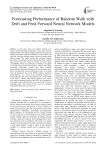
Forecasting Performance of Random Walk with Drift and Feed Forward Neural Network Models
Статья научная
In this study, linear and nonlinear methods were used to model forecasting performances on the daily crude oil production data of the Nigerian National Petroleum Corporation (NNPC). The linear model considered here is the random walk with drift, while the nonlinear model is the feed forward neural network model. The results indicate that nonlinear methods have better forecasting performance greater than linear methods based on the mean error square sense. The root mean square error (RMSE) and the mean absolute error (MAE) were applied to ascertain the assertion that nonlinear methods have better forecasting performance greater than linear methods. Autocorrelation functions emerging from the increment series, that is, log difference series and difference series of the daily crude oil production data of the NNPC indicates significant autocorrelations. As a result of the foregoing assertion we deduced that the daily crude oil production series of the NNPC is not firmly a random walk process. However, the original daily crude oil production series of the NNPC was considered to be a random walk with drift when we are not trying to forecast immediate values. The analysis for this study was simulated using MATLAB software, version 8.03.
Бесплатно
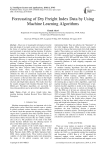
Forecasting of dry freight index data by using machine learning algorithms
Статья научная
Discovery of meaningful information from the data and design of an expert system are carried out within the frame of machine learning. Supervised learning is used commonly in practical machine learning. It includes basically two stages: a) the training data are sent to as input to the classifier algorithms, b) the performance of pre-learned algorithm is tested on the testing data. And so, knowledge discovery is carried out through the data. In this study, the analysis of Lloyd data is performed by utilizing Gradient Boosted Trees and Multi-Layer Perceptron learning algorithms. Lloyd data consist of the Baltic Dry Index, Capesize Index, Panamax Index and Supramax Index values, updated daily. Accurate prediction of these data is very important in order to eliminate the risks of commercial organization. Eight datasets from Lloyd data are obtained within the frame of two scenarios: a) the last three index values in the freight index datasets; b) the last three index values in both crude oil price and freight index datasets. The results show that the models designed with Gradient Boosted Trees and Multi-Layer Perceptron algorithms are successful for Lloyd data prediction and so proved their applicability.
Бесплатно

Formal and Informal Modeling of Fault Tolerant Noc Architectures
Статья научная
The suggested new approach based on B-Event formal technics consists of suggesting aspects and constraints related to the reliability of NoC (Network-On-chip) and the over-cost related to the solutions of tolerances on the faults: a design of NoC tolerating on the faults for SoC (System-on-Chip) containing configurable technology FPGA (Field Programmable Gates Array), by extracting the properties of the NoC architecture. We illustrate our methodology by developing several refinements which produce QNoC (Quality of Service of Network on chip) switch architecture from specification to test. We will show how B-event formalism can follow life cycle of NoC design and test: for example the code VHDL (VHSIC Hardware Description Language) simulation established of certain kind of architecture can help us to optimize the architecture and produce new architecture; we can inject the new properties related to the new QNoC architecture into formal B-event specification. B-event is associated to Rodin tool environment. As case study, the last stage of refinement used a wireless network in order to generate complete test environment of the studied application.
Бесплатно
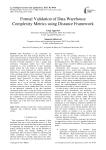
Formal validation of data warehouse complexity metrics using distance framework
Статья научная
Data Warehouse is the cornerstone for organizations that base their strategic decisions on the large scale processing of numerical data. The success of the organization depends on these decisions and hence it becomes extremely important to have a quality data warehouse. Conceptual models have been widely recognized as a key determinant of data warehouse quality during the early stages of design. Recently, metrics have been proposed by authors based on hierarchies to quantify the complexity and inturn quality of the conceptual models of data warehouse. They have formally corroborated the measures against Briand’s property based framework to ensure their validity. However, Briand’s set of properties for software measures are a set of necessary but not sufficient measure axioms. They are advantageous to refute software metrics but not to validate them. Thus, we focus on the theoretical validation of the data warehouse conceptual model metrics using the Distance framework whose sufficiency is ensured by the measurement theory. The results indicate that the metrics are valid measures of the complexity of data warehouse conceptual models. Besides, validation by Distance framework assures that the metrics are in the ratio scale which further aids in data analysis.
Бесплатно
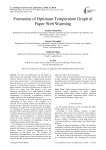
Formation of optimum temperature graph of paper web warming
Статья научная
To date, the requirements for the quality of paper products are increasing. At the same time, the most common trend in recent years is improving the resource and energy conservation of all technological processes. From the point of view of specialists in the field of paper industry in technological process of production on a paper machine, the greatest attention must be paid to the drying of a paper web. This process is the most expensive and decisive for a large number of quality parameters of finished products. In order to satisfy these requirements, it is necessary to implement a system of optimal control for this technological process. The first and one of the most important parts of the development of such system is the formation of a criterion for the optimal control and calculation of the optimal mode of operation of the first stage of drying - the heating of a paper web. For this purpose, the problem of calculating the optimal temperature graph of heating the paper web in the drying section of a paper machine is considered. Proposed quality control criterion ensures the maintenance of the parameters of finished products within the limits defined by the standard. Established limitations on the dynamics of temperature change on each drying cylinder and the final values. The calculation of the optimal temperature schedule is made by taking into account the characteristics of the material, the changes in the parameters of heat and mass transfer, which are functional dependences on the temperature of the paper web. The formulas for calculating the temperature of the paper at the exit from each drying cylinder and the free movement sections are based on the data on partial pressure on the surface of the paper web and in the environment. Results of the work are presented in the form of a step-by-step algorithm. Implementation of the developed algorithm ensures uniform heating of the paper web and reaches the optimum temperature for effective removal of moisture.
Бесплатно
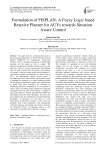
Статья научная
The paper presents a detailed discussion on the structural organisation of a Fuzzy Inference System Planner (FISPLAN) for Autonomous Underwater Vehicles (AUVs), including elaboration of membership functions for the inputs as well as outputs. The inference mechanism is detailed with discussions on the rule base, which in essence incorporates the planning logic. In order to assess the effectiveness of the planner as a means of reactive escape under critical situations, a case study is studied with reference to a state of the art AUV. An approximate subsea current model is developed from field observations, and residual energy is estimated by referring to a typical Lithium-polymer cell discharge characteristic together with data recorded in actual field trials. Situations are simulated by considering different combinations of sea-currents as well as status of resident energy. Results reveal that the simulated system, by virtue of the planner, is capable of perceiving situations, thereby realizing their imminence and making a decisive action thereupon. In concise, the fuzzy planner may be considered to provide human-like perception of situations on the basis of crisp observations. Furthermore dynamics of the system are modelled with actual parameters, and subsequently controller responses for pitching and velocity correction are illustrated. Choice of planning interval is also expressed as a function of the controllers' response.
Бесплатно
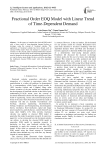
Fractional Order EOQ Model with Linear Trend of Time-Dependent Demand
Статья научная
In this paper we introduce the classical EOQ model with a linear trend of time-dependent demand having no shortages using the concept of fractional calculus. The application of fractional calculus has been already used in classical EOQ model where the demand is assumed to be constant. In this present article fractional differential calculus can be used to describe EOQ model with time-dependent linear trend of demand to develop more generalized EOQ model. Here, we want to discuss more deeply its role as a tool for describing the traditional classical EOQ model with time dependent demand.
Бесплатно
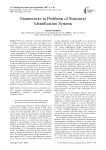
Frameworks in Problems of Structural Identification Systems
Статья научная
The new approach to structural identification of nonlinear dynamic systems under uncertainty is pro-posed. It is based on the analysis of virtual frameworks (VF), reflecting a state of a nonlinear part system. Con-struction VF is based on obtaining special an informa-tional set describing a steady state of a nonlinear dynamic system. Introduction VF demands an estimation of structural identifiability of a system. This concept is associated with nonlinearity of system and properties VF. The method of an estimation of structural identifiability is proposed. The appearance of the insignificant virtual frameworks, not satisfying to the condition of structural identifiability, is considered. Algorithms for an estimation of a nonlinearity class on the basis of the analysis of sector sets are proposed. Methods and procedures of the estimation of framework single-valued and multiple-valued nonlinearities are proposed. The method of the structurally-frequency analysis is proposed and applied to validate the obtained solutions. VF is proposed for identification of an order and a spectrum of eigenvalues of a linear dynamic system. The possibility of application VF for the problem solving of identification static systems is shown.
Бесплатно
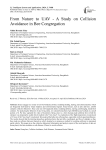
From Nature to UAV - A Study on Collision Avoidance in Bee Congregation
Статья научная
Insects engage in a variety of survival-related activities, including feeding, mating, and communication, which are frequently motivated by innate impulses and environmental signals. Social insects, such as ants and bees, exhibit complex collective behaviors. They carry out well-organized duties, including defense, nursing, and foraging, inside their colonies. For analyzing the behavior of any living entity, we selected honeybees (Apis Mellifera) and worked on a small portion of it. We have captured the video of honeybees flying close to a hive (human-made artificial hive) while the entrance was temporarily sealed which resulted in the” bee cloud”. An exploration of the flight trajectories executed and a 3D view of the” bee cloud” constructed. We analyzed the behaviors of honeybees, especially on their speed and distance. The results showed that the loitering honeybees performed turns that are fully coordinated, and free of sideslips so thus they made no collision between themselves which inspired us to propose a method for avoiding collision in unmanned aerial vehicle. This paper gives the collective behavioral information and analysis report of the small portion of data set (honeybees), that bee maintains a safe distance (35mm) to avoid collision.
Бесплатно
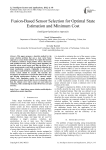
Статья научная
This paper proposes a heuristic method for the sensor selection problem that uses a state vector fusion approach as a data fusion method. We explain the heuristic to estimate a stationary target position. Given a first sensor with specified accuracy and by using genetic algorithm, the heuristic selects second sensor such that the fusion of two sensor measurements would yield an optimal estimation in a target localization scenario. Optimality in our method means that a trade-off between estimation error and cost of sensory system should be created. The heuristic also investigates the importance of proportion between the range and bearing measurement accuracy of selected sensor. Monte Carlo Simulation results for a target position estimation scenario showed that the error in heuristic is less than the estimate error where sensors are used alone for estimation, while considering the trade-off between cost and accuracy.
Бесплатно
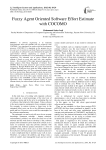
Fuzzy Agent Oriented Software Effort Estimate with COCOMO
Статья научная
In software engineering is an important issue,predicates effort and schedule time for projects.In 1995 COCOMO 2 was introduced for modern software development processes .COCOMO 2 Is dependent on the program size in sloc and a set of cost drivers and Scale Factors given according to each phase of software life cycle. Defined by the agent, the agent-oriented software engineering is created a new development, was introduced as a new methodology in software engineering. The estimated cost of aspect oriented effort estimate is based on event, rule, goal, task, state machines features . We presented in This paper proposed approaches to reduce projects effort Mean Magnitude of Relative Error (MMRE) Than the actual amount for agent oriented software engineering, through Methods:Total sloc agent element,Total weighted sloc,Total pure fuzzy agent sloc,Total weighted fuzzy sloc,Total weighted fuzzy sloc *fuzzy element,Geometric mean For fuzzy sloc per item, Harmonic mean for fuzzy sloc per item, fuzzy combinatorial proposed system of elements density via determine the size of the three agent oriented projects And apply them to the COCOMO 2 model. Among the proposed approaches, fuzzy combinatorial proposed system of agent elements density are achieved better and more accurate results.
Бесплатно
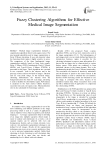
Fuzzy Clustering Algorithms for Effective Medical Image Segmentation
Статья научная
Medical image segmentation demands a segmentation algorithm which works against noise. The most popular algorithm used in image segmentation is Fuzzy C-Means clustering. It uses only intensity values for clustering which makes it highly sensitive to noise. The comparison of the three fundamental image segmentation methods based on fuzzy logic namely Fuzzy C-Means (FCM), Intuitionistic Fuzzy C-Means (IFCM), and Type-II Fuzzy C-Means (T2FCM) is presented in this paper. These algorithms are executed in two scenarios– both in the absence and in the presence of noise and on two kinds of images– Bacteria and CT scan brain image. In the bacteria image, clustering differentiates the bacteria from the background and in the brain CT scan image, clustering is used to identify the abnormality region. Performance is analyzed on the basis cluster validity functions, execution time and convergence rate. Misclassification error is also calculated for brain image analysis.
Бесплатно
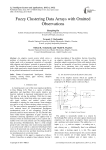
Fuzzy Clustering Data Arrays with Omitted Observations
Статья научная
An adaptive neural system which solves a problem of clustering data with missing values in an online mode with a permanent correction of restorable table elements and clusters' centroids is proposed in this article. The introduced neural system is characterized by both a high speed and a simple numerical implementation. It can process information in a real-time mode.
Бесплатно
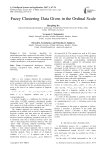
Fuzzy Clustering Data Given in the Ordinal Scale
Статья научная
A fuzzy clustering algorithm for multidimensional data is proposed in this article. The data is described by vectors whose components are linguistic variables defined in an ordinal scale. The obtained results confirm the efficiency of the proposed approach.
Бесплатно
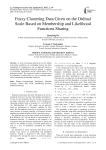
Статья научная
A task of clustering data given on the ordinal scale under conditions of overlapping clusters has been considered. It's proposed to use an approach based on membership and likelihood functions sharing. A number of performed experiments proved effectiveness of the proposed method. The proposed method is characterized by robustness to outliers due to a way of ordering values while constructing membership functions.
Бесплатно
Fuzzy Controller Design using FPGA for Sun Tracking in Solar Array System
Статья научная
The output power produced by high-concentration solar thermal and photovoltaic systems is directly related to the amount of solar energy acquired by the System, and it is therefore necessary to track the sun’s position with a high degree of accuracy. This paper presents sun tracking generating power system designed and implemented in real time. A tracking mechanism composed of photovoltaic module, stepper motor ,sensors, input/output interface and expert FLC implemented on FPGA, that to track the sun and keep the solar cells always face the sun in most of the day time. The proposed sun tracking fuzzy controller has been tested using Matlab/Simulink program; the simulation results verify the effectiveness of the proposed controller and shows an excellent result.
Бесплатно
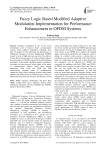
Статья научная
Adaptive modulation is one of the recent technologies used to improve future communication systems. Many adaptive modulation techniques have been developed for the improving the performance of Orthogonal Frequency Division Multiplexing (OFDM) system in terms of high data rates and error free delivery of data. But uncertain nature of wireless channel reduces the performance of OFDM system with fixed modulation techniques. In this paper, modified adaptive modulation technique has been proposed which adapts to the nature of communication channel based upon present modulation order, code rate, BER and SNR characterizing uncertain nature of communication channel by using a Fuzzy Inference System which further enhances the performance of OFDM systems in terms of high transmission data rate and error free delivery of data.
Бесплатно
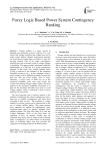
Fuzzy Logic Based Power System Contingency Ranking
Статья научная
Voltage stability is a major concern in planning and operations of power systems. It is well known that voltage instability and collapse have led to major system failures. Modern transmission networks are more heavily loaded than ever before to meet the growing demand. One of the major consequences resulted from such a stressed system is voltage collapse or instability. This paper presents maximum loadability identification of a load bus in a power transmission network. In this study, Fast Voltage Stability Index (FVSI) is utilized as the indicator of the maximum loadability termed as Qmax. In this technique, reactive power loading will be increased gradually at particular load bus until the FVSI reaches close to unity. Therefore, a critical value of FVSI was set as the maximum loadability point. This value ensures the system from entering voltage-collapse region. The main purpose in the maximum loadability assessment is to plan for the maximum allowable load value to avoid voltage collapse; which is important in power system planning risk assessment. The most important task in security analysis is the problem of identifying the critical contingencies from a large list of credible contingencies and ranks them according to their severity. The condition of voltage stability in a power system can be characterized by the use of voltage stability indices. This paper presents fuzzy approach for ranking the contingencies using composite-index based on parallel operated fuzzy inference engine. The Line Flow index (L.F) and bus Voltage Magnitude (VM) of the load buses are expressed in fuzzy set notation. Further, they are evaluated using Fuzzy rules to obtain overall Criticality Index. Contingencies are ranked based on decreasing order of Criticality Index and then provides the comparison of ranking obtained with FVSI method.
Бесплатно
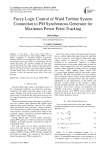
Статья научная
In this paper, a fuzzy logic control (FLC) is proposed for maximum power point tracking (MPPT) in wind turbine connection to Permanent Magnet Synchronous Generator (PMSG). The proposed fuzzy logic controller tracks the maximum power point (MPP) by measurements the load voltage and current. This controller calculates the load power and sent through the fuzzy logic system. The main goal of this paper is design of the fuzzy logic controller in the model of DC-DC converter (boost converter). This method allows the MPPT controller output (duty cycle) adjusts the voltage input to the converter to track the maximum power point of the wind generator.
Бесплатно

